Heart Rate Modulation
Parasympathetic nervous system (PSNS) activity releases acetylcholine on muscarinic 2 receptors yielding
beta/gamma dimers & inhibitory alpha subunits from G proteins. The dimers activate acetylcholine-activated potassium (KACh)
channels while the inhibitory alpha subunits decrease activation of adenyl cyclase leading to decreased heart rates.
Sympathetic nervous system (SNS) activity releases epinephrine & norepinephrine on beta receptors yielding stimulatory alpha subunits
from G proteins. The subunits activate adenyl cyclase that converts ATP to cAMP that directly stimulates hyperpolarization-activated
cyclic nucleotide-gated (HCN) channels and activates phosphokinase A (PKA). PKA activates calcium (CaL) channels, ryanodine receptors (RYR2),
sarcoplasmic reticulum calcium ATPase (SERCA) and phospholamban (PL) leading to increased heart rates
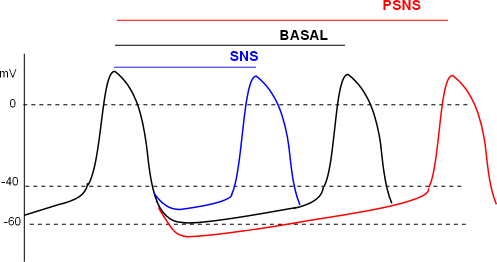 The individual effects of ANS activities on channels and pumps combine to give the characteristic patterns shown at the right.
However, the description of the isolated effects that result from SNS and PSNS activities on the individual targets is instructive.
The individual effects of ANS activities on channels and pumps combine to give the characteristic patterns shown at the right.
However, the description of the isolated effects that result from SNS and PSNS activities on the individual targets is instructive.
CaL Channel
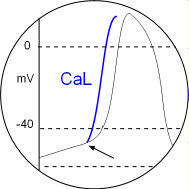 Activated PKA phosphorylates CaL channels that moves their activation potential to a more negative value as indicated by the arrow
so that depolarization begins sooner thus increasing heart rate.
Activated PKA phosphorylates CaL channels that moves their activation potential to a more negative value as indicated by the arrow
so that depolarization begins sooner thus increasing heart rate.
HCN Channels
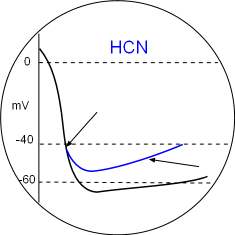 The binding of cyclic AMP to C-terminal receptors on the hyperpolarization-activated cyclic nucleotide-gated channels has two effects.
The binding sets the activation potential to a less negative value so that that diastolic depolarization begins sooner (first arrow).
The second effect is that the open configuration is facilitated at all potentials causing the diastolic depolarization slope (second arrow)
to increase and reach the CaL activation threshold sooner thus increasing heart rate.
The binding of cyclic AMP to C-terminal receptors on the hyperpolarization-activated cyclic nucleotide-gated channels has two effects.
The binding sets the activation potential to a less negative value so that that diastolic depolarization begins sooner (first arrow).
The second effect is that the open configuration is facilitated at all potentials causing the diastolic depolarization slope (second arrow)
to increase and reach the CaL activation threshold sooner thus increasing heart rate.
SERCA & PL
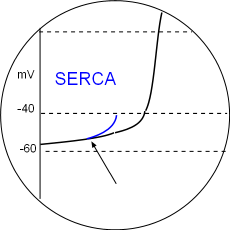 Phosphorylation of SERCA enzymes increases the rate at which the sarcoplasmic reticulum is refilled so that the threshold of calcium
ion concentration in the junctional SR is reached more quickly. Phospholamban (PL) phosphorylation removes the inhibitory effect of this
protein also facilitates filling. Local calcium releases (LCRs) begin sooner during diastolic depolarization
as indicated by the arrow in the illustration. Accordingly, the CaL activation threshold will be reached sooner thus increasing heart rate.
Phosphorylation of SERCA enzymes increases the rate at which the sarcoplasmic reticulum is refilled so that the threshold of calcium
ion concentration in the junctional SR is reached more quickly. Phospholamban (PL) phosphorylation removes the inhibitory effect of this
protein also facilitates filling. Local calcium releases (LCRs) begin sooner during diastolic depolarization
as indicated by the arrow in the illustration. Accordingly, the CaL activation threshold will be reached sooner thus increasing heart rate.
RYR2
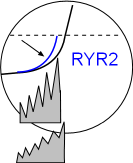 Phosphorylation of RYR2 channels facilitates larger local calcium releases so that the sodium calcium exchangers work at a faster rate
as shown by the increase in the exponential shape of the curve. The result is that the CaL threshold will be reached sooner thus
increasing the heart rate.
Phosphorylation of RYR2 channels facilitates larger local calcium releases so that the sodium calcium exchangers work at a faster rate
as shown by the increase in the exponential shape of the curve. The result is that the CaL threshold will be reached sooner thus
increasing the heart rate.
KACh Channels
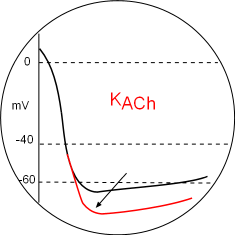 Parasympathetic (PSNS) effects will decrease all of the above effects due to the alpha inhibitory subunits inhibition of adenyl cyclase.
However, the most obvious effect on the action potential graph is due to hyperpolarize the membrane (arrow) by the opening of
acetylcholine-activated potassium channels. This is mediated by beta/gamma dimers from G proteins associated with muscarinic 2 receptors. These dimers bind to
the C-terminals of the channel's proteins thus opening the channel. Due to the lower mean diastolic potential it will take more time to
reach the CaL activation threshold thus decreasing the heart rate.
Parasympathetic (PSNS) effects will decrease all of the above effects due to the alpha inhibitory subunits inhibition of adenyl cyclase.
However, the most obvious effect on the action potential graph is due to hyperpolarize the membrane (arrow) by the opening of
acetylcholine-activated potassium channels. This is mediated by beta/gamma dimers from G proteins associated with muscarinic 2 receptors. These dimers bind to
the C-terminals of the channel's proteins thus opening the channel. Due to the lower mean diastolic potential it will take more time to
reach the CaL activation threshold thus decreasing the heart rate.
Updated:4/9/2015
Return to previous tutorial... ANS
Return to home page
 The individual effects of ANS activities on channels and pumps combine to give the characteristic patterns shown at the right.
However, the description of the isolated effects that result from SNS and PSNS activities on the individual targets is instructive.
The individual effects of ANS activities on channels and pumps combine to give the characteristic patterns shown at the right.
However, the description of the isolated effects that result from SNS and PSNS activities on the individual targets is instructive. Activated PKA phosphorylates CaL channels that moves their activation potential to a more negative value as indicated by the arrow
so that depolarization begins sooner thus increasing heart rate.
Activated PKA phosphorylates CaL channels that moves their activation potential to a more negative value as indicated by the arrow
so that depolarization begins sooner thus increasing heart rate.  The binding of cyclic AMP to C-terminal receptors on the hyperpolarization-activated cyclic nucleotide-gated channels has two effects.
The binding sets the activation potential to a less negative value so that that diastolic depolarization begins sooner (first arrow).
The second effect is that the open configuration is facilitated at all potentials causing the diastolic depolarization slope (second arrow)
to increase and reach the CaL activation threshold sooner thus increasing heart rate.
The binding of cyclic AMP to C-terminal receptors on the hyperpolarization-activated cyclic nucleotide-gated channels has two effects.
The binding sets the activation potential to a less negative value so that that diastolic depolarization begins sooner (first arrow).
The second effect is that the open configuration is facilitated at all potentials causing the diastolic depolarization slope (second arrow)
to increase and reach the CaL activation threshold sooner thus increasing heart rate.  Phosphorylation of SERCA enzymes increases the rate at which the sarcoplasmic reticulum is refilled so that the threshold of calcium
ion concentration in the junctional SR is reached more quickly. Phospholamban (PL) phosphorylation removes the inhibitory effect of this
protein also facilitates filling. Local calcium releases (LCRs) begin sooner during diastolic depolarization
as indicated by the arrow in the illustration. Accordingly, the CaL activation threshold will be reached sooner thus increasing heart rate.
Phosphorylation of SERCA enzymes increases the rate at which the sarcoplasmic reticulum is refilled so that the threshold of calcium
ion concentration in the junctional SR is reached more quickly. Phospholamban (PL) phosphorylation removes the inhibitory effect of this
protein also facilitates filling. Local calcium releases (LCRs) begin sooner during diastolic depolarization
as indicated by the arrow in the illustration. Accordingly, the CaL activation threshold will be reached sooner thus increasing heart rate. Phosphorylation of RYR2 channels facilitates larger local calcium releases so that the sodium calcium exchangers work at a faster rate
as shown by the increase in the exponential shape of the curve. The result is that the CaL threshold will be reached sooner thus
increasing the heart rate.
Phosphorylation of RYR2 channels facilitates larger local calcium releases so that the sodium calcium exchangers work at a faster rate
as shown by the increase in the exponential shape of the curve. The result is that the CaL threshold will be reached sooner thus
increasing the heart rate. Parasympathetic (PSNS) effects will decrease all of the above effects due to the alpha inhibitory subunits inhibition of adenyl cyclase.
However, the most obvious effect on the action potential graph is due to hyperpolarize the membrane (arrow) by the opening of
acetylcholine-activated potassium channels. This is mediated by beta/gamma dimers from G proteins associated with muscarinic 2 receptors. These dimers bind to
the C-terminals of the channel's proteins thus opening the channel. Due to the lower mean diastolic potential it will take more time to
reach the CaL activation threshold thus decreasing the heart rate.
Parasympathetic (PSNS) effects will decrease all of the above effects due to the alpha inhibitory subunits inhibition of adenyl cyclase.
However, the most obvious effect on the action potential graph is due to hyperpolarize the membrane (arrow) by the opening of
acetylcholine-activated potassium channels. This is mediated by beta/gamma dimers from G proteins associated with muscarinic 2 receptors. These dimers bind to
the C-terminals of the channel's proteins thus opening the channel. Due to the lower mean diastolic potential it will take more time to
reach the CaL activation threshold thus decreasing the heart rate.